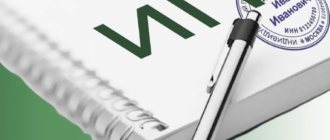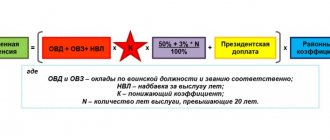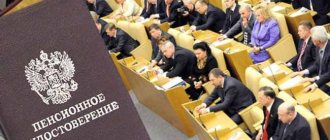Right to work
Taking into account the provisions of modern pension legislation, a citizen is not at all obliged to retire upon reaching retirement age. He can continue to work. This will help him accumulate more pension points, and therefore increase the amount of pension payments.
However, there are a number of nuances that must be taken into account when making a decision about delayed retirement. And the first of them is retirement age.
In 2020, the retirement age in the country is increasing. Without taking into account the transition period, it will be 65 years for men and 60 years for women. During the transition to the new rules, a systematic increase is provided - by 1 year annually to the previous age. Regarding the 2020 retirement age, the increase will occur as follows:
- 2019 – +1 year;
- 2020 – +2 years;
- 2021 – +3 years;
- 2022 – +4 years;
- 2023 – +5 years.
At the same time, the state proposes to abandon well-deserved rest and apply for pension benefits later than the statutory retirement age. In this case, the authorities increase the size of the fixed payment and index the accumulated pension points in a special manner.
For example, if you apply for a pension only a year later, the increase will be +7% to the value of the point and 5.6 to the size of the fixed payment. But if you retire, say, 7 years after retirement age, then the size of the increase will be more impressive: 74% to the value of the point and 58% to the size of the fixed payment.
Moscow resident Sofya V. turned to a lawyer for help in resolving an issue related to retirement. The fact is that she worked as an accountant all her life, she has a good salary. A woman’s right to a pension will arise in the second half of 2020, taking into account the transition period. But at a consultation with the Pension Fund of the Russian Federation, she was recommended to postpone her retirement until 2024, justifying this step with benefits in the form of an increased pension. The lawyer calculated that such a step would not be beneficial for Sophia if she wanted to continue working.
So is such a transition beneficial? Let's try to count. But for simplicity of calculations, 2020 “prices” and the average indexation of pensions to an inflation rate of 3.5% will be accepted.
Advantages
Now it has become profitable to go into a well-deserved retirement a little later than the appointed age. Indeed, in this case, bonus coefficients are assigned annually to the pension. For example, if an insured pensioner wants to give up his pension for a three-year period, then the pension payment will increase by 1.19 and the insurance pension by 1.24.
Premium coefficients are one of the main concepts of the pension calculation formula. The coefficients are calculated taking into account the time of non-receipt of pension benefits.
Benefits of retiring late:
- The final amount of the joint venture will be increased by the established coefficient.
- While the employee is working, insurance premiums are paid for him, so the amount of insurance payment increases.
- A working citizen of retirement age has greater financial security than one who does not work.
Retirement 5 years later
Another abstract citizen decides to postpone his well-deserved rest and continues to work in his previous position while maintaining his salary level. During this period, the man will earn an additional 12.41 pension points, that is, by the time he retires he will already have 111.75 pension points.
Thus, his pension without taking into account bonus factors should be 15,083 rubles. 26 kopecks, of which:
- RUB 9,749.07 – by the amount of pension points;
- RUB 5,334.19 – according to the size of fixed payments.
But taking into account the bonus coefficient, these figures will be indexed, and the pension will be 21,390.65 rubles. In annual terms, this is already 256,687.80 rubles.
It would seem that the benefits of a deferred pension are obvious. But is there a catch?
Don't rely on retirement, start saving
Sergey Chetverikov - director of investor relations at the crowdinvesting platform StartTrack
Forget about pension
You don’t need to count on a pension, it won’t happen. The budget deficit of the Russian Pension Fund (PFR) in 2018 will be 151.9 billion rubles, the funded part of the pension was frozen until 2020. Even with a surplus of the Pension Fund of Russia and a salary of 300,000 rubles. per month your pension will not exceed 30,000 rubles. That is, in old age you will not be able to afford the same standard of living as now.
How much do you spend on basic necessities today? For example, for rent, food, gifts for children, travel? Let it be 50,000 rubles per month. Now multiply them by 12 months a year and 30 years - you get 18 million rubles. This is the minimum (at current prices and with current spending patterns, of course) that you need to have by the time you retire to maintain your current standard of living. Why 30 years, you ask? Well, at least because the average life expectancy in the world is 80 years (and continues to grow), and some of the current working people want to retire at the age of 50.
Divide your money into three baskets
Any person’s salary should be divided into three parts - daily expenses, savings and investments. Before investing, you need to accumulate savings - at least 5 monthly salaries. This amount will be a “safety cushion” in case of job loss, illness or unexpected expenses. With a cushion, you can start investing in long-term instruments. If you urgently need money, spend the “cushion”, that is, you will not have to sell shares at an unfavorable price or, even worse, withdraw money from circulation.
Investments are longer-term investments (in stocks, bonds, mutual funds, businesses) that are designed to generate high income. Why is a bank deposit not an investment? Having deposited 500,000 rubles. on a bank deposit at 6% per annum, in 10 years you will earn only 1 million rubles. We can say that your money was not working, but was simply lying there and trying not to depreciate due to inflation.
And if we take, for example, a conservative investment portfolio (low-risk stocks and bonds), its average annual return will be 10-15%. That is, over 10 years, 500,000 rubles. may increase to 2 million rubles. The expected profitability of loans to small and medium-sized businesses through crowdinvesting platforms is 20-25% per annum.
In the West, various types of investment instruments are used by everyone, from students to retirees. Europeans know how not only to competently assemble a portfolio, allocating no more than 15% of free capital to one instrument, but also to determine a psychologically comfortable level of risk for themselves and more or less accurately calculate the return on investment. What barriers do we need to overcome to become savvy investors?
Start early
In general, you need to think about investing as early as possible: from the age of 20-25, as soon as you get your first job. We are surprised when we arrive at a foreign resort: how many pensioners there are! European, American. Why can they afford it, but our grandparents cannot? And all because the state pension is far from the only source of income for them. On average, it makes up just over a third of their monthly income. Many older Americans have extra savings in a variety of retirement accounts, either employer-provided or Individual Retirement Account (IRA). Speaking of IRAs. Using it, Americans buy shares or bonds of companies and states or invest in any other assets: gold, real estate, oil futures, vintage cars, timber, etc. And then, after a certain time, they get the money back plus interest.
For the elderly - bonds, for the young - stocks
Let's say you have created a safety net and accumulated free capital. Now the question before you is: how to distribute money between different investment instruments? This depends on two factors:
- A person's attitude towards risk. A conservative person will not survive even a small loss of money. Therefore, a large share of his savings should be low-risk assets (bank deposits, government bonds). How do you know how much risk you are willing to take? Take a special test. They usually contain questions like: “What level of return is satisfactory for you - one that will be equal to the deposit rate and will be stable, or much higher, but will be associated with risky instruments?” Or: “At what Bitcoin rate will you start to get nervous?” I can say about myself that I am ready for a high degree of risk, and if I chose a financial instrument with a yield of 5% per annum, I would very soon begin to get nervous, watching how everyone around me, taking risks, earns more.
- Age. The younger a person is, the more money he can invest in high-risk instruments. Use a simple formula to calculate your savings to investment ratio. How old you are now is the percentage of low-risk instruments (savings). For example, you decide to buy government bonds (a low-risk instrument). If you are 30 years old, your portfolio should be no more than 30% bonds. If you are 80, then, accordingly, 80%.
The share of risky instruments is calculated differently: this is all the money left after your risk-free investments. In other words, if at the age of 30 you decided - in addition to bonds - to purchase shares or finance a business by concluding an investment loan agreement with the founder of the company or purchasing a share in the authorized capital, you can safely allocate 70% of your free money for this.
All these calculations are confirmed by practice. Thus, the average age of 3,500 investors on the StartTrack platform is 35 years. But the first “people’s” OFZs were bought by pensioners in 2017.
How can this be explained? Over a long period of time (and life span, for obvious reasons, is longer for the young than for the elderly), investments more often bring positive income. Even during crises, wars and epidemics. If you also invest in a diversified portfolio of securities (in dozens of different companies or financial instruments), then you can sleep peacefully. Even if two years out of ten to twenty have negative returns, you will still make a profit in the end.
Take the future into your own hands
To save money for retirement, it is not at all necessary to deny yourself the usual joys, although it is the desire to live “here and now” that does not allow us to think about savings. Let's say your salary is 100,000 rubles. If you save 20% of this amount every month, you will accumulate 240,000 rubles in a year. “What is it - for a whole year I can save only two salaries? - many will be surprised. - And for this, should I forget about restaurants, switch to an economical car from the road, or even start using public transport? No, save it yourself..."
I usually answer such skeptics: “At the age of 30 you will have saved up 1.2 million rubles. and you can invest them in moderately conservative instruments with a yield of 10-15% per annum. Annually replenishing the portfolio with the same 240,000 rubles. (20% of your annual salary), by the age of 55 you will earn 90 million rubles.” Quite enough for a comfortable old age.
It’s hard to force yourself to save - I agree, but only at the beginning, and then you get used to it. Remember that investments are the key to your future life. Start small, build up a cushion, educate yourself, meet experienced investors and create your own investment portfolio. Perhaps this will become your calling and passion. Why not?
Let's look at the benefits
Of course, postponing retirement seems extremely beneficial on the surface. This is also a fairly high standard of living with a peer who retired on time - after all, the salary is 30% -100% more than the pension. This also means a higher monthly income after retirement. But the numbers tell a slightly different story.
If a citizen retires on time, then in 5 years he will receive (taking into account the average indexation of 3.5% annually) 900,894 rubles. For the same period, a citizen who has not retired will receive 0 rubles. in the form of a pension and 1,428,000 rubles. salaries. At the time of retirement, the difference in total income will be 527,106 rubles.
So far, all calculations show the reasonableness of deferring pensions. But for some reason no one takes into account the right of a pensioner to continue working after retirement. And here it turns out that a pensioner who continues to work will receive many times more funds.
A working pensioner, even taking into account the indexation freeze, will receive a total of 1,428,000 rubles over 5 years. salaries and another 840,000 rubles. pensions excluding annual adjustments. Total 2,268,000 rub. And what will a citizen who chose delayed retirement receive during the same period? Only 1,428,000 rubles. The difference is 840,000 rubles. This is much more than the initially stated “benefit”.
How many years will it take to cover the difference?
Let's assume that for 5 years the indexation of pensions was 3.5% annually. At the age of 70, when both of them decide to end their working career, their pension will be accrued in accordance with all wages and indexation missed by the working pensioner.
Thus, a citizen who has worked an additional 5 years after retirement will receive 17,308 rubles, and a 70-year-old elderly person who has just retired will receive 24,546 rubles. The difference is 41%, which in annual terms is RUB 86,854.5.
It will take about 10 years to close the gap in income actually received, that is, a citizen who has postponed retirement will be in a more advantageous position at the age of 80. But here we should take into account the simplest factor: not every man in Russia lives to the age of 80. Average life expectancy at birth (according to Rosstat calculations made in 2018) is only 77.7 years in 2035. For women the figure is slightly higher – 85.01. And this is a high forecast; the low figures are much more modest - 70.74 and 80.06 years.
Due to frequent updates to legislation and the legal uniqueness of each situation, we recommend obtaining a free telephone consultation with a lawyer. You can ask your question by calling the hotline number 8 (800) 555-40-36 or write it in the form below.








